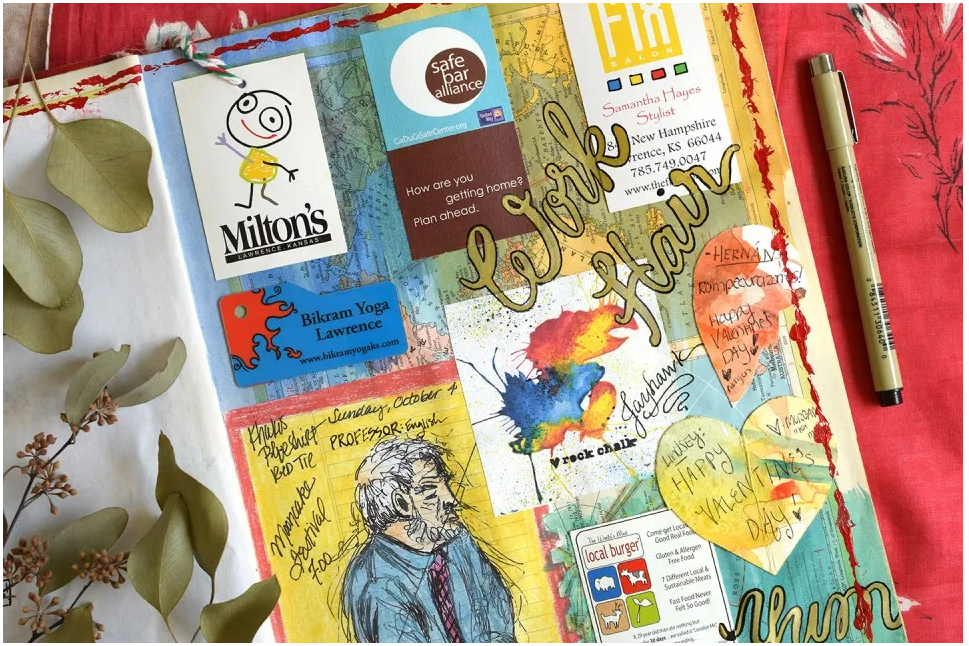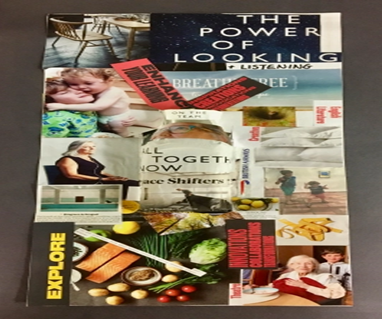This #Take5 is brought to you from Debbie Holley – with guest bloggers Tom Burns and Sandra Sinfield from LondonMet’s Centre for Professional and Educational Development (CPED) (see also their student studyhub).
Debbie is reflecting on her move to Bournemouth’s Department of Nursing where she is Professor of Digital Innovation. Whilst Debbie has always researched digitally enhanced teaching and learning – the challenge of the last year was adapting that to a Nursing focus – and in a time of pandemic. Don’t panic!

‘Mere jelly’ – Student image reproduced with permission from ‘Facilitating Student Learning’ Unit, London Metropolitan University
In my year with the Department of Nursing, I have been privileged to observe the embodiment of the humanising curriculum (Todres et al 2009), and seen the ways in which the nursing team, in a wide range of contexts, support students to bond with each other, build cohort identity and help student nurses develop that sense of belonging to the academic discipline of Nursing. This is challenging enough, but studying and learning are also embodied activities. How can we get our students ready to bring their whole embodied selves into their learning experience when they are working from home and online?
Sian Bayne, Professor of Digital Education, Edinburgh University, talks about embodiment in her paper ‘Mere Jelly’ in which she outlines the proposition that cyberstudents can create and colonise spaces in their own choosing (Moravec 1988: 117):
[my] essence [is defined by] the pattern and the process going on in my head and body, not the machinery supporting that process. If the process is preserved, I am preserved. The rest is mere jelly.
For staff, she draws upon Dreyfus, and for online learning suggests that thinking beyond the cognitive, considering the duality of the mind/body split. In health, this is clear in terms of the physicality of the disciplines (Dreyfus 2001: 48):
Only emotional, involved, embodied human beings can become proficient and expert and only they can become masters. So, while they are teaching specific skills, teachers must also be incarnating and encouraging involvement.
The pressure of delivery of content is pressing. In a face-to-face classroom we can struggle to weave in those student spaces to talk and learn from each other – creating what Bakhtin would call dialogic learning spaces – those where students engage with content by engaging with each other; and with ideas in both embodied and intellectual ways of working.
Clarifying the expectations of the digital is a clear requirement in our new learning spaces, as our students (and indeed we ourselves) become less able to pick up on visual and body language cues. Nordman et al (2020) suggest 10 ways of facilitating this in their recent paper, highlighting the importance of signposting and building online communities.
Creativity is an evidence based method for supporting our students with dialogic and collaborative learning. The ‘Visual Learning’ CETL, based at the University of Brighton, have an extensive range of resources, and the ‘Draw to learn’ booklets include Sciences, Health, Humanities and Business.
Dreyfus (2001 p 173) went on to pose the question:
“we finally run up against the most important question a philosopher can ask those who believe in the educational promise of the World Wide Web: can the bodily presence required for acquiring skills in various domains and for acquiring mastery of one’s culture be delivered by means of the Internet?”
We have been exploring visual practices as ways of enhancing and reinforcing learning for many years now – and enjoyed the challenge of wrestling these into our new online and at a distance spaces. We share three of them below and invite you to select an activity from the three options below to use with your own students.
Tip: Creative activities can prove a challenge for time poor students – who wonder why we are wasting their time in these frivolous ways. Hence, always conclude a creative activity with some form of dialogic ‘de-brief’ so that the students can come to realise and appreciate the power of the activity for themselves.
And as what works for student learning works for us as well – you might like to de-brief yourself at the end of a session – perhaps asking yourself:
- What has surprised the students in their own/ others creations?
- Has the activity challenged my own ideas of study in the discipline?
- What can students take from the activity to enrich their own learning going forward?
- Do the activities we have offered our students start to offer insights and links between theory and practice? We would welcome thought pieces, feedback and ideas as a response to create a further Londonmet/AldinHE #Take 5 national blogpost.
Embodiment and ‘Being there’: three different ways of engaging students with study: for reuse, repurpose or adaptation across the disciplines
The study ready apron: an example of ‘reuse’
Create a ‘study apron’, perhaps referencing ‘study skills’. This activity is suitable for students of any discipline, but works really well for health professionals as it promotes fine motor skills and physical dexterity.

Ask the students to design their apron ready for their discipline modules to come – so a good tip would be to scout module handbooks:
- Is there a specific requirement in a module for such a journal to be kept? Do we need a pocket for this?
- Do we need a pocket to keep a small notebook in for real time and creative notes?
- Do you need a pocket or not (for an Iphone)?
Resource:
Start by watching Simones’ video – Simone is a lecturer in an Arts Department, and prepared this stopframe video for her own students in the first instance: https://youtu.be/ty_ztNPoEp4
Materials:
They will need a large old pair of jeans/ shirt/item – and transform the pair of jeans or similar into a study apron. To capture digitally, you could set up a twitter hashtag, ask the students to send you a photo, which you can then incorporate into a powerpoint display and upload onto the VLE, or organise them into breakout rooms to debrief.
The reflection on the process of making is the key learning… some questions you can use as a debrief in a generic study context:
- Did I find it fruitful to make and think?
- What is the best part of my apron?
- If I made a second apron, what would I do differently?
- Having made this, do I feel differently about entering uni?
- Do I feel like a ‘proper’ student yet?
The drawing journal: an example of repurposing

Ask students to keep a visual learning journal or sketchbook.
Why Journal? Why notes? What are creative notes?
Keeping a journal encourages active reflection on learning – and without reflection there is no learning! Asking for visual reflections encourages the growth of understanding – for it is difficult to represent what you do not yet understand. The drawings themselves also act as powerful mnemonics or memory aids.
Moreover, keeping a reflective journal encourages research, forward thinking and promotes engagement.
Suggest your students draw an image a day that represents either their study journey, or an image that represents one aspect of learning about their discipline. This is the process of repurposing one medium for another, and helps promote idea generation, reflection and creativity.
Resources:
‘how to make a sketchbook and why you should do this’.
Brighton’s Site about the evidence base re drawing.
Paper by Paul McIntosh, introducing drawing to a cohort of nurses and health professionals.
Debrief in a health context:
- What did I select as my study for make/think?
- What is the best part of my sketchbook ?
- If I choose a second set of images, what would I choose and why?
- Having made this, do I feel differently about Nursing/ my discipline?
- Do I feel like a ‘proper’ student now?
Collage: an example of adaptation
The Aim is for the students to source clean recyclables, items in cupboard, fruit bowl, buttonbox, lego if available, plasticine if available, and to make a representation of learning, of University experience thus far, what they think their course is like.

Staff self portrait from Abegglen, Burns and Sinfield (2020)
Students share via social media as above, send images to tutor to be collated, post onto class padlet (a padlet is an interactive board for sharing information in a visually appealing format – you can set up 3 for free)
Debrief in a reflective practice/ interdisciplinary context
- What did I make/think?
- What is the best part of my creation?
- If I was to recreate my representation, would it be the same/ different and why?
- Having made this, do I feel differently about Nursing/ my discipline?
- Do I feel like a ‘proper’ student now?
Evidence base:
English, F., 2011. Student writing and genre: Reconfiguring academic knowledge. A&C Black.
James, A. and Nerantzi, C. eds., 2019. The power of play in higher education: Creativity in tertiary learning. Springer.
Abegglen, S. Burns, T. and Sinfield, S. (forthcoming 2020) ‘Dada, Montage and the Dalek: The Game of Meaning in Higher Education’ in International Journal of Management and Applied Research
Further reading:
Abegglen, S. Burns, T. and Sinfield, S. (2020) ‘Dada, Montage and the Dalek: The Game of Meaning in Higher Education’ in International Journal of Management and Applied Research [online]: http://www.ijmar.org/v7n3/20-016.html
Bayne, S., 2004, April. ‘Mere jelly’: the bodies of networked learners. In Networked Learning 2004: proceedings of the fourth International Conference on Networked Learning (pp. 372-379).
Dreyfus, H., 2001. How far is distance learning from education?. Bulletin of Science, Technology & Society, 21(3), pp.165-174.
McIntosh, P., Webb, C. and Walk, R., 2006, July. Creativity and reflection: An approach to reflexivity in practice. In Fifth International Conference on Self-Study of Teacher Education Practices Leeds, UK. Retrieved October (Vol. 26, p. 2005).
Moravec, H., 1988. Mind children: The future of robot and human intelligence. Harvard University Press.
Nordmann E, Horlin C, Hutchison J, Murray J-A, Robson L, Seery MK, and MacKay JRD. 2020. 10 simple rules for supporting a temporary online pivot in higher education. PsyArXiv Preprints.https://psyarxiv.com/qdh25
Todres, L., Galvin, K.T. and Holloway, I., 2009. The humanization of healthcare: A value framework for qualitative research. International Journal of Qualitative Studies on Health and Well-being, 4(2), pp.68-77.
Waight, S. and Holley, D. (2020) ‘Digital Competence Frameworks: their role in enhancing digital wellbeing in Nursing Curricula’ in Humanising Higher Education: A positive approach to enhancing wellbeing (Clarke, S and Devis-Rozental, C eds) Palgrave 2020
Additional resources for creative working:
The Pomodoro Technique® – proudly developed by Francesco Cirillo | Cirillo Consulting GmbH
How to write an assignment fast (6-min video): https://www.youtube.com/watch?v=nZlGmOazg_k&t=1s
BLURBS
Debbie Holley is Professor of Learning Innovation in the Department of Nursing Sciences at Bournemouth University. A passionate educator, she is a National Teaching Fellow; a Principal Fellow of AdvanceHE and served for six years on the Association of Learning Developers in Higher Education (ALDinHE) national Steering Group. She is a long standing member of the JISC Student Experience Experts panel; and has recently worked with as part of an international consortium to identify the next Augmented/Virtual/Mixed Reality trends in education. Follow Debbie on twitter @debbieholley1
Tom Burns and Sandra Sinfield are Teaching Fellows and Seniors Lecturers in LondonMet’s Centre for Professional and Educational Development. Together they have produced the 4th edition of Essential Study Skills, the Study Hub for students and the #Take5 for staff. They are both interested in harnessing creative and emancipatory practice in student learning and staff development.
